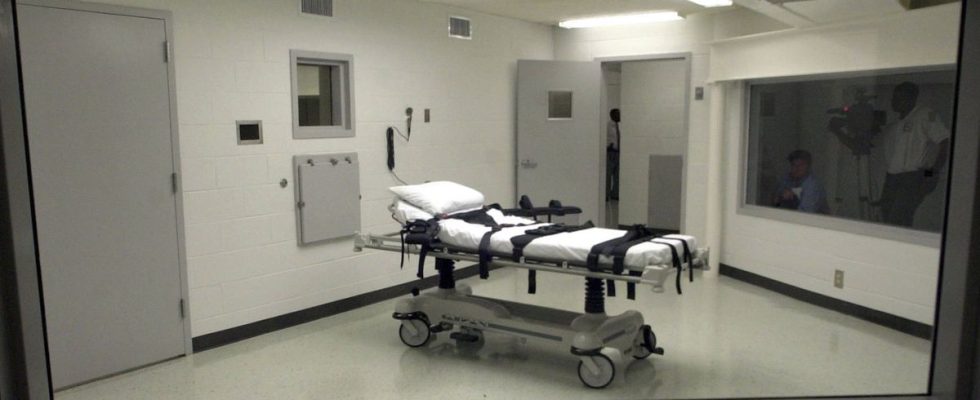Have the person breathe nitrogen until they suffocate… and die. This new method of execution is to be used this Thursday to kill Eugene Smith, a 58-year-old American inmate sentenced to death. The state of Alabama, but also those of Oklahoma and Mississippi, have added nitrogen hypoxia to the arsenal of killing methods used in the country.
But North America is far from being the only area of the globe where the death penalty is still practiced. Saudi Arabia, Iraq, Iran, Egypt, India, China, Japan, Vietnam, Indonesia… Around fifty states continue to sentence prisoners to capital execution. Nearly 900 people were executed in 2022 in 20 countries according to Amnesty International’s annual report. A figure which does not include executions which probably took place in China, North Korea and Vietnam, where this data is classified as a state secret, nor “executions” committed in theaters of war. In total, six methods of execution are used throughout the world, without it being known which is the most practiced.
Lethal injection
The condemned man is strapped to a table, a catheter installed in one of his veins. One or more medicinal substances are then injected in a lethal dose. Three chemical substances are used, according to Amnesty International: sodium thiopental, intended to quickly put the condemned to sleep; pancuronium bromide, which paralyzes muscles and causes respiratory arrest; and potassium chloride, which causes cardiac arrest.
Used since 1982 in the United States, this lethal method has become more difficult to carry out in recent years. Because since 2010, a large number of pharmaceutical laboratories have spoken out against the use of their products to carry out these killings. In addition, several “botched” executions have reignited controversy over the effectiveness of lethal injections in the country. This method was also used in China and Vietnam in 2022, according to Amnesty International.
Stoning
Stoning is a form of execution in which a group of individuals throw stones at the condemned person until the latter dies from blunt force trauma. Article 102 of the Iranian Penal Code specifies that men will be buried up to the waist and women up to the chest.
This particularly cruel form of execution is applied in cases of adultery in Iran, Sudan, Brunei and Afghanistan. In Brunei, it can also be imposed in cases of sexual relations between people of the same sex.
In Iran, a moratorium on executions by stoning was declared in 2002, but it was never respected. In Sudan, the government promised in 2015 to remove death by stoning as a form of punishment. According to human rights groups, this promise was never followed through on.
Hanging
In most countries where it is practiced, hanging consists of positioning the condemned person on a trapdoor, before putting the rope around their neck. The trap door then opens under his feet and the body falls. In this way, the cervical vertebrae are spread apart, the spinal cord is cut and death is instantaneous. In Iran, the condemned person is lifted up and dies of asphyxiation.
Many countries have resorted to hanging in 2022: Bangladesh, Egypt, Iraq, Iran, Japan, Burma, Singapore, South Sudan and even Syria.
The decapitation
In Saudi Arabia, the convicted person is brought to a public square. She is forced to kneel, head down, before having her head cut off with a saber. Sometimes, the remains of the tortured person are crucified, “to set an example,” according to the Saudi Interior Ministry.
This method is now only practiced by Saudi Arabia, according to Amnesty International. As a reminder, decapitation was practiced in France until the death penalty was banned in 1981.
The electric chair
With this method, the condemned person is strapped to a wooden chair and then electrodes are placed on his shaved head and around his ankles. High voltage is administered two or three times in a row for a few seconds, until it causes death.
Only the United States maintains the electric chair as an alternative method of execution to lethal injection. In February 2008, the Nebraska Supreme Court officially banned the use of the electric chair in that state, ruling that the method was contrary to human dignity and therefore unconstitutional.
By gun
This execution technique consists of shooting the condemned person with a bullet in order to damage one of their vital organs and cause their death. In some countries, only one weapon is used by a police officer. In others, death is carried out by firing squad. One of the rifles is then loaded with blanks, allowing each soldier to believe that he is not the author of a fatal bullet.
In 2022, death by firearm was practiced in many territories such as Afghanistan, Belarus, China, Kuwait, North Korea, Palestine, Somalia and Yemen, according to Amnesty International.

